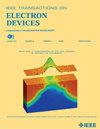采用 TiN/SiO₂/Hf₀.₅Zr₀.₅O₂/SiOx/Si (MIFIS) 栅极结构的顶部 SiO₂ 夹层厚度对硅沟道 FeFET 存储窗口的影响
IF 2.9
2区 工程技术
Q2 ENGINEERING, ELECTRICAL & ELECTRONIC
引用次数: 0
摘要
我们研究了顶层 SiO2 中间膜厚度对采用 TiN/SiO2/ Hf0.5Zr0.5O2/SiOx/Si(MIFIS)栅极结构的硅沟道铁电场效应晶体管(FeFET)存储窗口(MW)的影响。我们发现,随着顶部 SiO2 中间层厚度的增加,MW 也随之增加,而且这种增加呈现出两级线性关系。其物理原因是在顶部 SiO2/Hf0.5Zr0.5O2 界面捕获了不同的界面电荷。此外,我们还研究了耐久特性与初始 MW 的关系。我们发现,随着初始 MW 的增加,耐久特性会降低。同时,我们还研究了顶部 SiO2 夹层厚度对 MIFIS 结构保持特性的影响。保持特性的结果表明,顶层 SiO2 较厚的 MIFIS 结构的保持特性较差。这归因于顶部 SiO2/Hf0.5Zr0.5O2 界面捕获的界面电荷的去捕获以及铁电体的去极化场。通过在栅极金属 TiN 和铁电体 Hf0.5Zr0.5O2 之间插入 3.4 nm 的 SiO2 介电夹层,我们实现了 6.3 V 的最大功率和超过 10 年的保持时间。我们的工作有助于铁弗晶体管的器件设计。本文章由计算机程序翻译,如有差异,请以英文原文为准。
Impact of Top SiO₂ Interlayer Thickness on Memory Window of Si Channel FeFET With TiN/SiO₂/Hf₀.₅Zr₀.₅O₂/SiOx/Si (MIFIS) Gate Structure
We study the impact of top SiO2 interlayer thickness on the memory window (MW) of Si channel ferroelectric field-effect transistor (FeFET) with TiN/SiO2/ Hf0.5Zr0.5O2/SiOx/Si (MIFIS) gate structure. We find that the MW increases with the increasing thickness of the top SiO2 interlayer, and such an increase exhibits a two-stage linear dependence. The physical origin is the presence of the different interfacial charges trapped at the top SiO2/Hf0.5Zr0.5O2 interface. Moreover, we investigate the dependence of endurance characteristics on initial MW. We find that the endurance characteristic degrades with increasing the initial MW. Meanwhile, we study the impact of the top SiO2 interlayer thickness on the retention characteristics of the MIFIS structure. The results of retention characteristics show that the MIFIS structure with thicker top SiO2 has poorer retention characteristics. This is attributed to the de-trapping of interfacial charges trapped at the top SiO2/Hf0.5Zr0.5O2 interface and the depolarization field of the ferroelectric. By inserting a 3.4 nm SiO2 dielectric interlayer between the gate metal TiN and the ferroelectric Hf0.5Zr0.5O2, we achieve a MW of 6.3 V and retention over 10 years. Our work is helpful in the device design of FeFET.
求助全文
通过发布文献求助,成功后即可免费获取论文全文。
去求助
来源期刊

IEEE Transactions on Electron Devices
工程技术-工程:电子与电气
CiteScore
5.80
自引率
16.10%
发文量
937
审稿时长
3.8 months
期刊介绍:
IEEE Transactions on Electron Devices publishes original and significant contributions relating to the theory, modeling, design, performance and reliability of electron and ion integrated circuit devices and interconnects, involving insulators, metals, organic materials, micro-plasmas, semiconductors, quantum-effect structures, vacuum devices, and emerging materials with applications in bioelectronics, biomedical electronics, computation, communications, displays, microelectromechanics, imaging, micro-actuators, nanoelectronics, optoelectronics, photovoltaics, power ICs and micro-sensors. Tutorial and review papers on these subjects are also published and occasional special issues appear to present a collection of papers which treat particular areas in more depth and breadth.
 求助内容:
求助内容: 应助结果提醒方式:
应助结果提醒方式:


